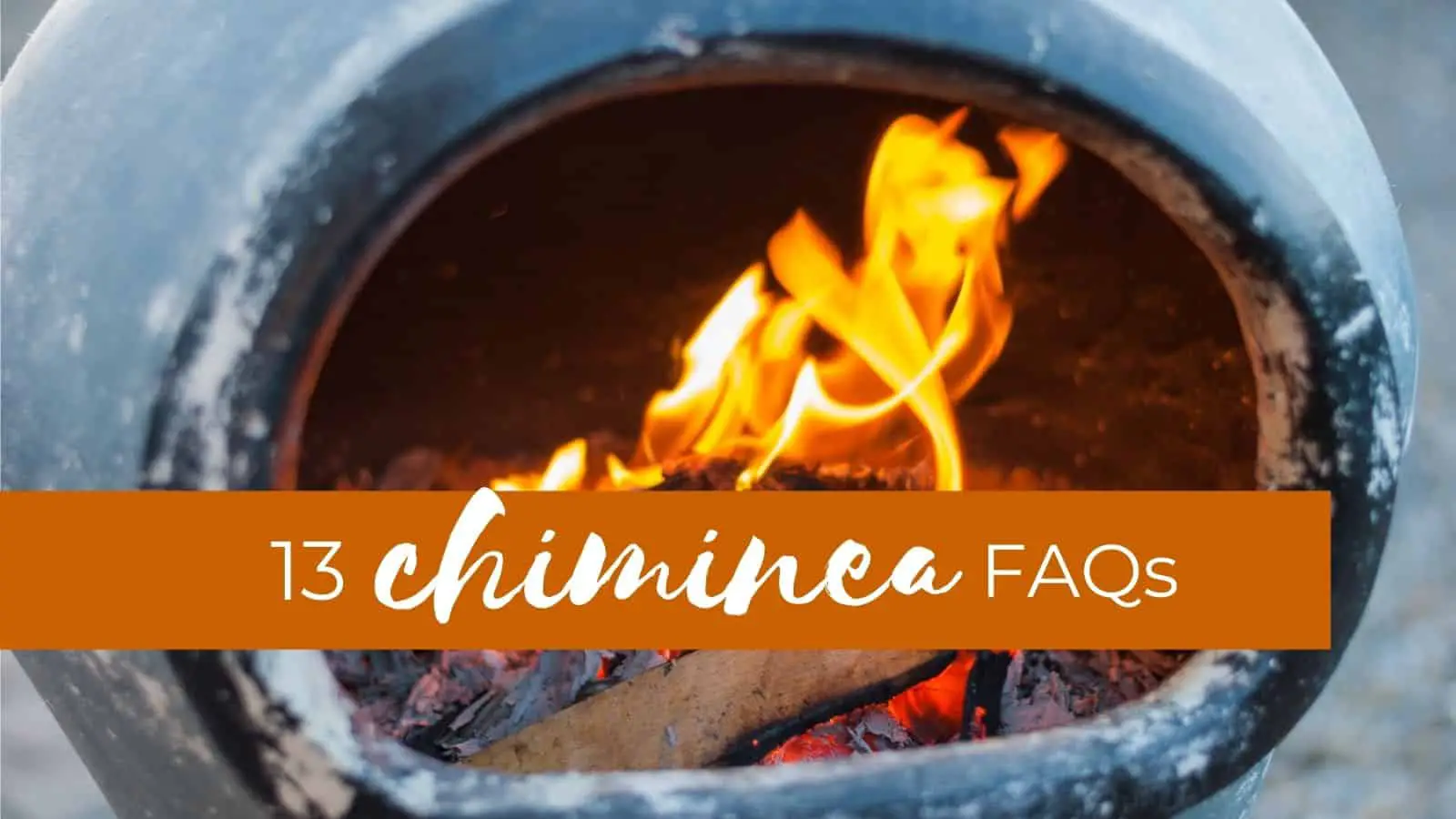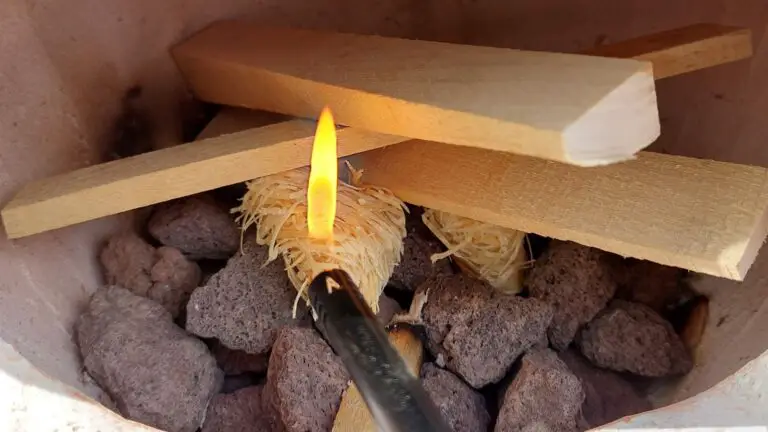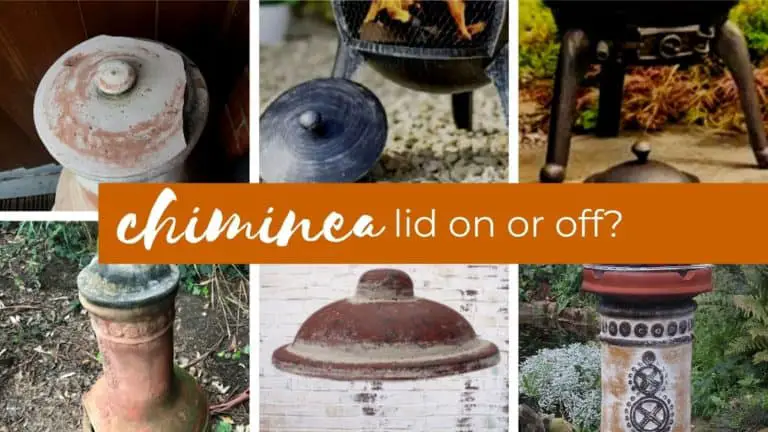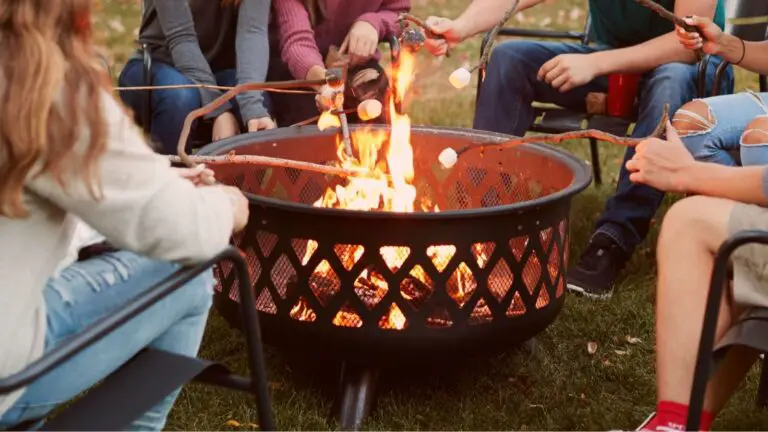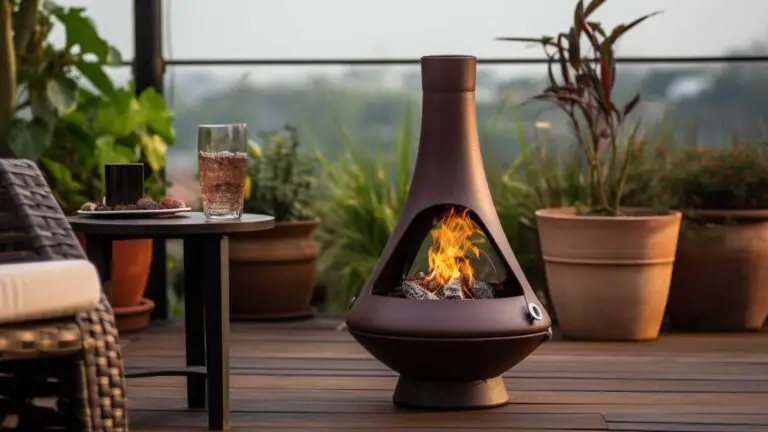Chimineas – 13 FAQs Answered
After a long cold winter, the thought of spring coming and sitting outside in your garden on a cool evening can be just the ticket. You may be thinking about getting that new chiminea to take advantage of these warmer evenings, but are not sure where to start – here are 13 chiminea FAQs answered.

1. Is a Chiminea Safer Than a Fire Pit?
Chimineas are safer than fire pits for a few reasons. Firstly the fire is more contained, making it generally easier to control and maintain. Fewer loose sparks that can fly out at any angle on a fire pit are limited to the mouth or the chiminea.
If you are worried about sparks with a chiminea, you can easily cover the mouth with a spark guard or similar. Many of the chiminea metal varieties come with a door that prevents anything unwanted from leaving the fire.
2. Will a Chiminea Keep you Warm?
There’s no doubt that chimineas are visually appealing but can they perform as outdoor heaters?
Yes, they sure can!
The heat from the fire will rise through the chimney stack and radiate outwards, heating anything nearby. The larger the chiminea, the more heat it will emit.
Remember, chimineas are made to house small, efficient fires that warm the immediate area. If you choose a metal chiminea, your heat radiation will extend further and be hotter.
Whether a chiminea will keep you warm is primarily dependent on three things:
- Outside air temperature when you start, if it’s colder than a witches tit, you’ll have an uphill battle on your hands regardless.
- Size of your chiminea – the larger your chim, the more heat it will put out.
- The material of your chiminea – clay is excellent but for the best heat radiation, go for metal (cast iron is the best).
You might also like this article about how hot a chiminea gets.
3. Can I Put a Chiminea Under a Patio?
No. The two main reasons why you should NOT put a chiminea under a patio are as follows – fumes and stray sparks. Wood and coal-burning chimineas should NEVER be used in an indoor or covered area.
The main threat is carbon monoxide – released from any fire, silent, potentially deadly, and needs to exit through the chiminea stack and into the air.
That’s why houses have chimneys built into fireplaces – so the fumes can escape to the outdoors easily and not affect the air quality of those inside.
4. Can you Still Use a Cracked Chiminea?

It depends. Small hairline cracks are common on clay chimineas, and these are fine. However, anything more substantial and your cracked chiminea becomes a safety hazard as your chiminea has been structurally compromised.
Stop using your chiminea immediately if you notice a crack, and then assess whether it is worth trying to fix. We have an article on repairing a clay chiminea that you can check out to get familiar with the process.
5. Can a Chiminea Be Used Indoors?
No. Chimineas are wood and charcoal burning fireplaces and should NOT be used for this purpose indoors.
A fire MUST have proper ventilation, and if the smoke does not choke you out, the carbon monoxide output fumes will get you.
Although you may come across examples of chimineas being adapted for indoors with extended chimneys – run away from this idea at great speed unless installed by a qualified expert. Perhaps consider getting an indoor wood-burning stove installed instead. It’s not worth risking the health and safety of you and your family to save a few bucks.
TIP – The same applies to all different types of patio heater – NEVER use them indoors.

Exceptions to this rule will involve using a chiminea indoors for decorative purposes and using candles or eco gas burners as a mini flame. Any candles or burners that were designed for indoor use could be used within a chiminea indoors.
For all the info on this – indoor chimineas.
Just remember not to expect much radiating heat from a candle but it’s still flame you’re dealing with – and children and pets should always be supervised as the chiminea will get hot.
6. How Long Do Chimineas Last?
Technically, chimineas can last anywhere from a few months to fifteen to twenty years if well looked after.
Several significant variants will determine the life expectancy of your chiminea.
- The material of your chiminea – cast iron chimineas are the longest lasting.
- Use of a chiminea cover – keeping your chiminea tucked up under a waterproof cover will considerably extend the lifespan as ALL chimineas hate water.
- Storing indoors during winter months – chimineas that are not only covered but also can be moved into a shed or garage for the long, cold and wet UK winter will preserve your chiminea for the most extended lifespan.
7. Should I Use Fire Accelerant in My Chiminea?
No. Using lighter fluid or petrol to start your chiminea fire is a horrible idea for 2 reasons:
- In the fire bowl of a chiminea, gases build up much faster and will explode when lit. Check out this guy’s story about when he used petrol on his chiminea:

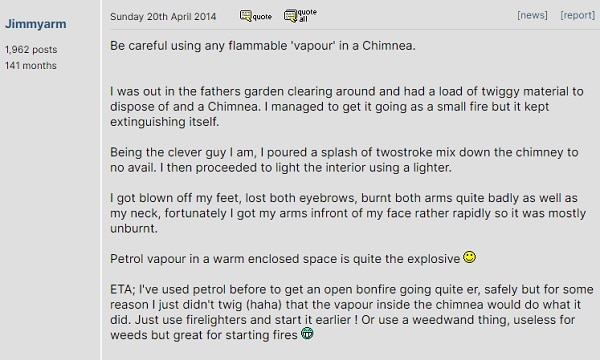
- The massive surge in temperature is likely to damage the structure of your chiminea.
However, some alternative fire starters are entirely safe for sensible use in a chiminea, and I love the wood wool fire starters like this one that I picked up in Home Bargains for a few pounds:
They are probably the equivalent of scrunching up a few sheets of newspaper…but who still reads newspapers? I’ve found these work super well, even in slightly challenging conditions.
If you are using newspaper, a few small squares of kerosene block firelighter is perfect for getting things going without worrying about being too hot.
8. Can I Paint My Chiminea?
Yes! It’s recommended you give your chim a coat of protection at least once a season, and you will dramatically improve its life expectancy.
Use special heat-resistant BBQ style paint on your metal chiminea and use a sealant on your clay chiminea.
For more information on painting a chiminea, check out our article.
9. How to Put Out My Chiminea Fire?
The best way to put out a chiminea fire is to stop adding fuel and simply let it die down over time. Chiminea fires should be small and die out within an hour or so of stopping fuel.
However, if you need to put out the fire, immediately throwing some sand on will quickly kill the fire. It’s a good idea as a safety precaution to have a bucket of sand nearby if you run into any issues.
TIP – Only use water to put out a chiminea as a LAST resort. The temperature shock will probably crack your lovely chiminea, and then you have a soggy mess to clean up later. Water is a chimineas worst enemy, and if it gets in your chim, it won’t last long.
10. Can I Move My Chiminea?
Yes, with some forward-thinking and common sense, you should be able to move a chiminea. However, chimineas come in all different shapes and sizes and therefore differ dramatically in their weights.
For more information on chiminea weights, we have a whole article for you.
If your chiminea is heavy, you could use a cart or trolly to move it.
When picking up a chiminea, never lift it by the stack (the chimney) because where the stack meets the fire bowl is the weakest point structurally on a chiminea.
11. Why Do I have to Cure My Clay Chiminea? Is it essential?
Yes, a clay chiminea will need to be cured. For the complete jackanory, check out our article how to cure a clay chiminea.
It’s always a good idea to start any chiminea off on its first burn with small fires, as this will reduce any risk of heat shock.
12. Do I Need to Put Sand in My Chiminea?
In clay chimineas, yes.
Sand helps lift the fire from the bottom of the fire bowl, which keeps that part of the chiminea somewhat protected as it’s, without doubt, one of the weakest points.
Also, fires like to be elevated where they have access to good airflow – chimineas are designed to draw in air through the mouth and feed the fire, and if the fire is sitting below the level of the bottom lip of the chiminea mouth, it’s just asking for problems.
13. Do I have to Cover my Chiminea?
Yes. If you want it to last more than one season….yes.
British weather is brutal on chimineas or anything else you are brave enough to abandon outside in your garden for the winter season.
The minimum protection you can give them from the water that they hate so much is to cover them up whenever they are not in use.
If possible, store your chiminea in a shed or garage over the winter. Keeping them tucked up indoors is the best protection from rain and cold temperatures.
If your chiminea is on the lighter side, consider weighing it down if you have to leave it outside. I’ve found that steel chimineas can like to be blown around when they’ve got the cover on. Seems to act like a bit of a parachute!
A couple of bricks on the inside is perfect.

